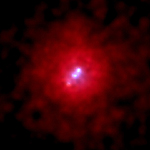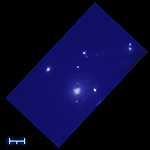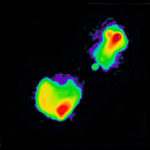CXC Home | Search | Help | Image Use Policy | Latest Images | Privacy | Accessibility | Glossary | Q&A
What Do These Images Tell Us?
X-ray

Angular size of box = 40 arcsec, corresponding to 900,000 light years
Photo: NASA/CXC/SAO
The X-ray image of 3C295 shows an explosive galaxy embedded in a vast
cloud of hot gas. This cloud, which contains over a hundred galaxies,
is more than two million light years in diameter and has a temperature
of fifty million degrees. The X-rays from the central galaxy are concentrated
in three bright knots that form a line. The central knot coincides
with the center of the galaxy; these X rays are probably produced
by matter falling into a supermassive black hole. The upper and lower
knots are in the same location as two large lobes of radio emission.
The distance from the top to the bottom knot is about 100,000 light
years, comparable to the diameter of our Milky Way galaxy.
Optical

scale bar = 2 arcsec, corresponding to 40,000 light years
Photo: NASA/HST/A.Dressler
In the optical image 3C295 appears as a giant elliptical galaxy that
is twice as luminous as our Milky Way galaxy. The galaxy extends beyond
the X-ray and radio lobes. The center, or nucleus of the galaxy is
not nearly as prominent as in X rays, although optical observations
do provide evidence for a large amount of gas at temperatures of about
10,000 degrees, which is apparently heated by ultraviolet and X radiation
from the nucleus.
Radio

Angular size of box = 8 arcsec, corresponding to 180,000 light years.
Photo: NRAO/VLS/R. Perley & G. Taylor
The radio image shows many similarities to the X-ray image: two lobes
on either side of the nucleus. The lobes have bright spots where the
radiation is especially intense. The radio lobes are produced by the
synchrotron process, where high-energy electrons move through a magnetic
field and radiate radio waves. If the energies of the electrons are
high enough, this process can also produce optical and X radiation.
Study of the radio lobes indicates that they were blasted out at high
speeds from the supermassive black hole in the nucleus less than a
million years ago.
Return to 3C295 (16 Nov 99)


